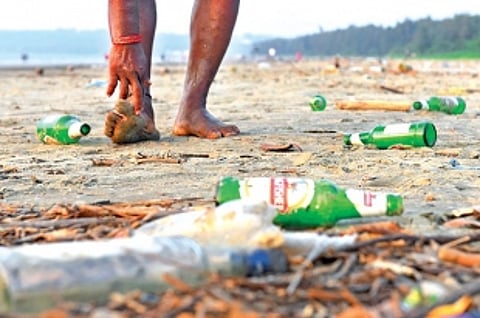

Goa has been a world-renowned tourism destination which attracts millions of domestic and international tourists since the 1960s. There has been a significant increase in tourists, from 2.78 million in 2012 to 8 million in 2019. Fringed by swaying coconut trees with cool and comfortable shacks, the beaches offer a variety of entertainment for tourists including beach parties, marine sports, etc. All these activities subsequently lead to the generation of a vast amount of anthropogenic waste that is ultimately discharged into the sea which is disastrous for marine aquatic life and the ecosystem with irreversible damages.
Several researchers have undertaken the study of marine litter to assess the spatial-temporal variation and impact of litter pollution on the environment. But a special study focusing on the changes in the status and composition during and post-Covid lockdown in 2020 was undertaken by researchers from Goa University and National Centre for Polar and Ocean Research, Ministry of Earth Sciences, Government of India under the supervision of Prof Kotha Mahender, School of Earth, Ocean and Atmospheric Sciences (SEOAS).
The PhD scholar Ritwik Nigam at SEOAS, took the COVID-19 pandemic as an opportunity to monitor and assess beach litter by surveying eight different Goa’s beaches, four each in the north (Calangute, Morjim, Miramar, and Siridao) and south districts (Baina, Velsao, Colva, Palolem) which are frequently visited by tourists (domestic and foreign). Drone reconnaissance was done to select beaches as entry to the beaches was restricted. Two spells for the survey were selected: one during May 2020, when the tourism-related activities came to a standstill due to COVID-19 lockdown, and the other during unlock period (January 2021), when tourism in Goa usually peaks every year (a business-as-usual scenario). Glass, plastic, thermacol, rubber, footwear, and metal were litter composition types considered in the study.
Litter density change between the two surveys was highest (559) for Calangute, followed by Miramar-Caranzalem (234), and 223 for Morjim. In the south, Baina showed 281, followed by Velsao and Colva (134-136). Surprisingly, it was -6.7 for Siridao. The difference increment in per capita share of beach litter among the population of respective coastal villages showed 558.62 for Calangute, 229 for Miramar-Caranzalem, 226 for Morjim, 1033 for Palolem, 276 for Baina, 135-137 for Velsao and Colva, and Siridao had exhibited -7.
Beach-wise variation in litter categories showed interesting statistics. Colva beach exhibited an increase in all the categories of litter ranging from 8% (plastic) to 429% (footwear). Glass litter increased (3103%) followed by rubber (2140%) and footwear (213%) for Palolem beach, while metal and thermocol showed a decrease by more than 70%. For plastic litter exceeding 2 kg, Colva beach ranked top, followed by Miramar-Caranzalem, Baina, Siridao, and Calangute. For footwear litter exceeding 1 kg for both periods, were found at Colva, Baina, Siridao, and Miramar. Glass litter exceeding 1 kg for all beaches in post-lockdown were also found. Calangute, Miramar, and Siridao showed metal litter exceeding 200 gms during both periods. Packaging materials like thermocol more than 100 gms were exhibited at Velsao, Siridao, Baina, and Colva.
The increase in glass litter (mostly liquor bottles) suggest that domestic tourists consume spirit on the beach and then venture into the water for swim. The high rate of drowning reported annually on Goa’s beaches is attributed to liquor consumption on beach front which also contributes to litter.
Overall, the results also revealed that a significant reduction in the mean litter from 28.31 g/m2 during peak tourist season to 10.04 g/m2 during the lockdown period. Miramar-Caranzalem (urban beach) and Baina (semi-urban beach) observed a reduction of 234%, and 288%, respectively during the lockdown period. Both the beaches are centrally located, which strongly indicates that locals and tourists were unable to visit these beaches. Siridao beach showed an increment (6.70%) during the lockdown period relative to the post-lockdown period.
Miramar beach, which is a popular picnic spot because of the many bushes on the shoreside was highly polluted with beach litter that was callously dumped by picnickers. Compared to earlier study the present study revealed that these beaches are comparatively cleaner, except for Miramar beach which exhibited ‘fair’ on the cleanness color-coded scale.
The researchers have made useful recommendations based on this study. The complacent behavior of tourists plays a significant role in beach litter generation and proper disposition. The majority of reduction can be done at the source itself, where the litter can be segregated by focusing on eliminating at least single-use plastics, which is bad for the natural ecosystem. A team comprising local residents, social workgroups, college students, and NGOs can be mobilised as volunteers to undertake beach monitoring and help the local administration to keep the beaches clean, and hygienic. It is essential to explore the potential of offering theme-based massive open online courses (MOOCs)/regular webinars/virtual screening to spread environmental education with a focus on litter reduction, facilitating greater awareness among people to develop local solutions to global problems in better litter management.
Besides, making a provision of incentives for plastic manufacturers to increase reuse and recycle culture. The use of UAV surveys, which are cost-effective, help to spot the litter concentration and provide effective beach monitoring.